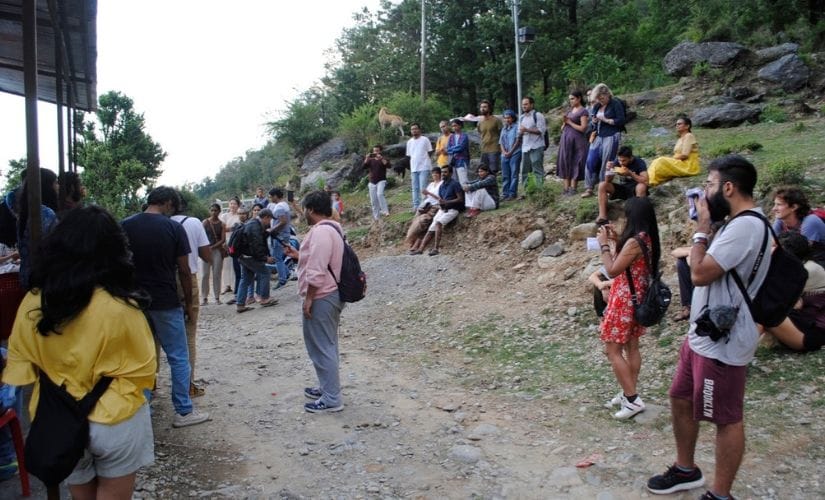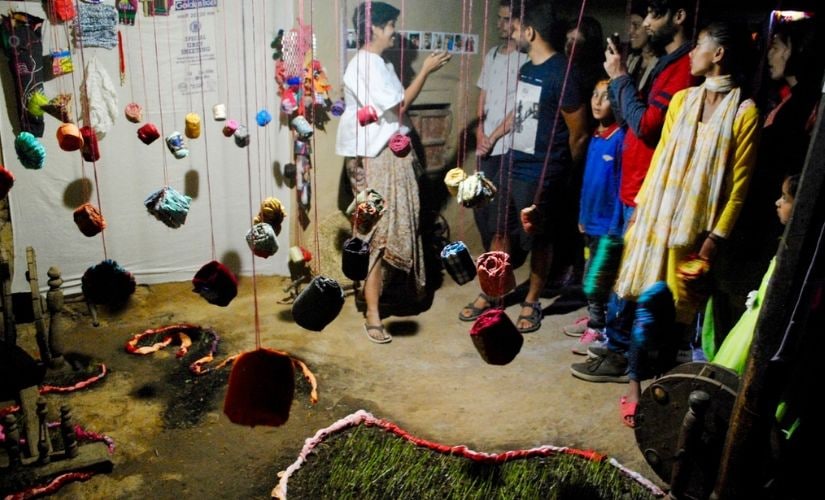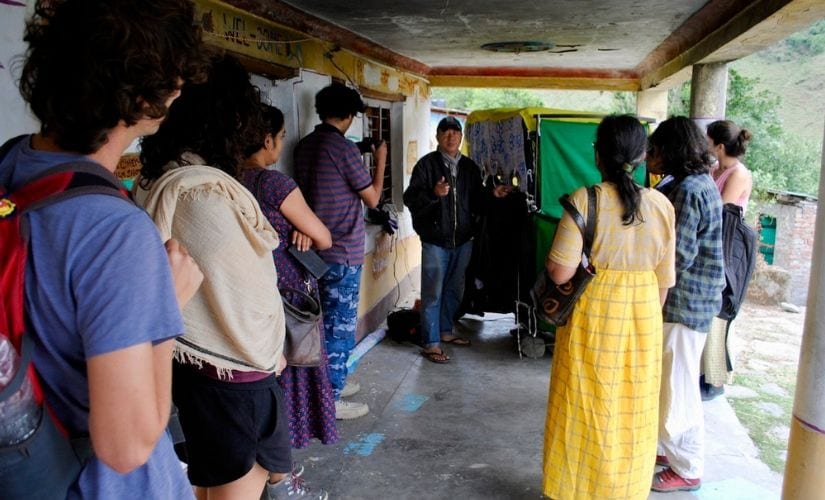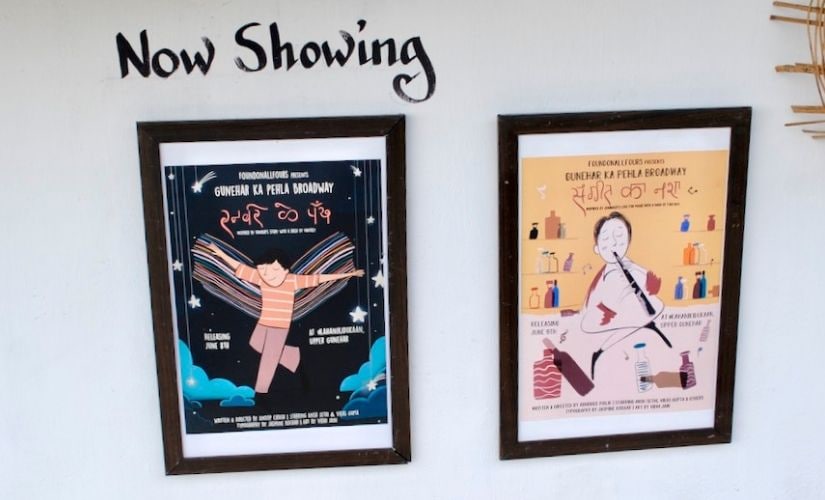On the way to the Bir Billing paragliding point in Himachal, one might spot a sizeable human traffic from above, moving around on a village trail this time of the year every few years. Gunehar, or Guned, as it is pronounced locally, is a village that made its presence felt in the contemporary art scene six years ago, with a triennale art festival organised by artist Frank Schilchtmann. One can barely miss the creatively done signage on approaching Gunehar. Earlier, the bustling market square would play host to the ShopArt ArtShop (SAAS) conceptual arts festival. However this year, Schilchtmann decided to take artists to the top of the village, thereby initiating the 1.6-kilometre-long Gunehar Art Trail. Old houses and deserted homes, mostly constructed in traditional pahadi style, have been used by artists to display their work. The fortnight-long affair has been turned into an artists’ residency and open art gallery that attracts hundreds of visitors every three years during summer. [caption id=“attachment_6841001” align=“alignnone” width=“825”]  On the art trail towards Gunehar[/caption] In its third edition this year, the SAAS triennale explored the theme “Borderline”, with eleven upcoming artists interpreting the term through music, cinema, ceramics, terracotta, painting, poetry, storytelling, theatre, and more. The artists explored the complexities of living in a world where borders and boundaries are being reimposed, instead of being dismantled. They attempted different ways of engaging with the theme, using vocabulary that is easily understood by common men and women. Artist Sultana Zana studied shifting borders of nature-human habitats at the point of intersection, where the trail ends and the forest begins. A student of nanotechnology and mathematics before joining Srishti Institute of Art Design in Bengaluru, Zana’s thought process reflects precision. She mapped the forest, microfilmed the kind of network the forest builds using micro-cameras, and concluded that the forest is not organically grown, it’s man-made. Therefore, there are no borders between the natural and human habitats. Fashion and textile designer, Pramila Choudhary says that through human history, fashion has been a major indicator of social change, and often, a bitter source of conflict. At Gunehar, she engaged in a constant dialogue with the locals to explore the shifting boundaries of fashion, to know what influences these changes — the ingredients, instruments and inspirations. She explored whether changing fashion influences the ’texture’ of society — does it alter the way people work, bond or interact with each other? Choudhary collected old photographs from local homes to get a sense of people’s sartorial choices in the past. A collection of bright, colourful left-over cloth pieces from local tailor shops physically records a shift in the choice of textiles, trends and tastes. But change in fashion does not translate into change in attitudes — people, she finds, still love their traditions and antiquity. Her public installation had wheat germinating on the floor, suggesting the rootedness of the local people, even though their colourful dreams and desires were shown dangling over. [caption id=“attachment_6841021” align=“alignnone” width=“825”]  Designer Pramila Choudhary at Gunehar Art Festival[/caption] *** A fascinating feature at the festival this year was Yash Sahai’s “Kangra Blues”, which explored the sonic landscape of the local singers and musicians through the retelling of a story on the community, in the voice of its people. In doing so, Sahai dissolved the boundaries between western and local music rather aesthetically. The piece incorporated local singers, including a hundred-year-old woman who narrated the tale of a young soldier who died, the shehnaiwallas, birds, cascading waters, and sounds of cattle. Sahai magically captured the flavour of the local music, rhythm of the village life, and coupled it with western harmony. His music introduces urban listeners to the soundscapes of a village in a musical vocabulary they understand. His CD, “Kangra Blues”, will soon be released online by SAAS. Children in Gunehar treat Singapore based artist, K. M. Lo, as their friend. He is the only artist who has participated in all three editions of SAAS, and his shop has always been among the most popular ones. Lo helps children explore their imagination, without being an imposing mentor. With his help, local children have made sci-fi films using easily available materials in the past. This year, instead of making a film, Lo demonstrated how simply, with simple things, magic can be created. He built a tuk-tuk with locally sourced materials and an in-built projector. Additionally, the tuk-tuk had a bioscope and a small cafe. “It can even be a flight simulator and children can pretend to drive the Millennium Falcon!” Lo says. [caption id=“attachment_6841031” align=“alignnone” width=“825”]  Singapore-based artist, K. M. Lo at Gunehar Art Festival[/caption] After successfully maintaining a ceramic studio in Mumbai for a decade, Devyani Smith reached a juncture in life that made her reflective about “the known and the unknown, the done and the undone, the life lived and the life to be lived”. For her, “Borderlines” is a deeply personal attempt to create “a place in the head where you put yourself before deciding where your next attachment is… A life between lives.” Reluctant to erect another studio “all over again”, Smith carried broken pieces of pottery lying around in her studio with her to Gunehar. Instead of making pottery, she used the broken pieces as a component, merging and blending them with other mediums, bringing parts from her past and present together to see what the future looks like. In doing so, Smith also rejected the idea of conventional beauty — synonymous with her work — by arranging the pieces in an unaesthetic way using the entire space. Her journey led her back to her strength of creating unconventional beauty. Amritah Sen was uncomfortable about creating another painting for the festival, but her works carry a strong narrative component — that of a painter and a narrator. Her take on “Borderline” came together while she was on the trail. The artist installed “Thode Dreams Baki Reality” in the kitchen of the last pukka house in the trail. People could write about their aspirations, touch the books and read them — after all, dreams are cooked up in the kitchen. “A lot of people who live in reality don’t realise the gap — that you can change perceptions about yourself on the other side of the gap," Sen says, saying that it’s like crossing the line of reality. [caption id=“attachment_6841061” align=“alignnone” width=“825”]  ‘Thode Dreams Baki Reality’ by Amritah Sen at Gunehar Art Festival[/caption] *** The Gunehar Broadway attracted hundreds of visitors, providing a platform for depicting tales on shifting boundaries between reality and fantasy, like the acts put up by Found On All Fours, a group of storytellers. Sarban Chowdhury, who works with ceramic and found objects, talked about urban encroachment to depict his understanding of “Borderlines”; Asmita Sarkar explored the psychology of “uncanny” to interpret the theme, while Gaurav Gokhale decoded it through a documentary film. There’s space for every artist and her art at Gunehar. Visitors and art aficionados aside, it’s unusual for villagers to be associated with conceptual art. However, locals at Gunehar are used to it, and it is their active participation that makes this triennale so refreshingly different. Since the inception of SAAS in 2013, the village community has been a part of the art-making process as not just witnesses, but participants as well. This year was no exception. Even though the theme did not involve the village, the village was an indispensable part of the process. [caption id=“attachment_6841071” align=“alignnone” width=“825”]  Gunehar Broadway posters[/caption] Traditional dham (a Himachali feast) food was served at the opening ceremony, with Gaddi dancers and local singers sharing stage. The finale on 15 June witnessed the usual music concert by Himachali artistes. When SAAS set sail six years ago, the idea was simply to convert empty shops, found in abundance in the hills, into creative spaces for budding artists. In the editions that followed, the festival and its residency programme produced some exceptionally pioneering work. “To do something with such intensity with just Rs 1.2 lakhs (crowdfunded), is a pittance. It reflects the pitiful state of culture in our country. In its third edition, I have to still struggle to fund it, even though it benefits so many emerging artists,” rues founder Schilchtmann. But the visitors — queueing outside shops, waiting for them to open — draw the proverbial silver lining for a promising space celebrating meaningful art for posterity.
The Gunehar Art Festival was held in Himachal Pradesh earlier this month. The triennale, now in its third edition, hosts budding artists for over half-a-month, exploring different themes through various artistic mediums. The theme of ‘borderlines’ was chosen this year.
Advertisement
End of Article


)
)
)
)
)
)
)
)
)



